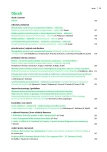Crush syndrome of today – rhabdomyolysis of intoxicateds
Authors:
Angela Molčányiová 1; Theodoz Molčányi 2; Miroslav Mydlík 3
Authors‘ workplace:
Laboratóriá Labmed, a. s., Košice, Slovenská republika, výkonný riaditeľ Ing. Vladimír Nestor
1; Klinika úrazovej chirurgie LF UPJŠ a UN L. Pasteura Košice, Slovenská republika, prednosta prof. MUDr. Miroslav Kitka, PhD.
2; IV. interná klinika LF UPJŠ a UN L. Pasteura Košice, Slovenská republika, prednosta prof. MUDr. Ivan Tkáč, PhD.
3
Published in:
Vnitř Lék 2014; 60(3): 249-254
Category:
Case Report
Overview
Crush syndrome is a major issue in war-afflicted countries and in times of peace also in case of a mining accident. This syndrome is characterized by a number of symptoms originating from muscle damage – rhabdomyolysis – resulting from long-lasting entrapment of the body/extremities. Nowadays, crush syndrome seems to be a scarce condition. However, the rare incidence may rather be the result of poor diagnostic recognition. Although the war conflicts and mining accidents became seldom, increased incidence of rhabdomyolysis is progressively associated with world-wide drug consumption. Long-term immobilisation of intoxicated drug addicts frequently leads to muscle damage, mediated by a local pressure exerted on the extremities. Rhabdomyolysis may become clinically manifest in a form of an acute muscular compartment syndrome.
Key words:
acute intoxication – acute muscular compartment syndrome – compartment pressure – dermofasciotomy – rhabdomyolysis
Sources
1. Barnard M. Rhabdomyolysis. Update in Anaesthesia 2012; 28 : 130–132.
2. Bocca G, van Moorselaar JA, Feitz WFJ et al. Compartment syndrome, rhabdomyolysis and risk of acute renal failure as complications of the lithotomy position. J Nephrol 2002; 15(2): 183–185.
3. Daher E de F, Cordeiro NF. Acute renal failure due to rhabdomyolysis. Rev Bras Med 1998; 55(7): 526–533.
4. Daher E de F, Silva Júnior GB, Brunetta DM et al. Rhabdomyolysis and acute renal failure after strenuous exercise and alcohol abuse: case report and literature review. Sao Paolo Med J 2005; 123(1): 33–37.
5. Daher E de F, Lima NA, Lima RSA et al. Acute Kidney Injury due to Rhabdomyolysis Followed by Alcohol Intake and Physical Aggression: case Report and Literature Review. J Medicine 2012; 13(2): 212–215.
6. David WS. Myoglobinuria. Neurol Clin 2000; 18(1): 215–243.
7. Gabow PA, Kaehny WD, Kelleher SP. The spectrum of rhabdomyolysis. Medicine 1982; 61(3): 141–152.
8. Haas CE, Magram Y, Mishra A. Rhabdomyolysis and Acute Renal Failure Following an Ethanol and Diphenhydramine Overdose. Ann Pharmacother 2003; 37(4): 538–542.
9. Holt SG, Moore KP. Pathogenesis and treatment of renal dysfunction in rhabdomyolysis. Int Care Med 2001; 27(5): 803–811.
10. Huerta-Alardín AL, Varon J, Marik PE. Bench-to-bedside review: Rhabdomyolysis – an overview for clinicians. Crit Care 2005; 9(2): 158–169.
11. Hunter JD, Gregg K, Damani Z. Rhabdomyolysis. Continuing Education in Anaesthesia, Critical Care & Pain 2006; 6(4): 141–143. Available at: http://ceaccp.oxfordjournals.org/content/6/4/141.full.pdf+html.
12. Kroužecký A, Matějovič M, Rokyta jr. R et al. Rabdomyolýza – mechanismy vzniku, příčiny, důsledky a léčba. Vnitr Lek 2003; 49(8): 668–672.
13. Lane R, Phillips M. Rhabdomyolysis. BMJ 2003; 327 (7407): 115–116.
14. Lopez JR, Rojas B, Gonzalez MA et al. Myoplasmic Ca2+ concentration during exertional rhabdomyolysis. Lancet 1995; 345 (8947): 424–425.
15. Mallinson RH, Goldsmith DJ, Higgins RM et al. Acute swollen legs due to rhabdomyolysis: initial management as deep vein thrombosis may lead to acute renal failure. BMJ 1994; 309(6965): 1361–1362.
16. Radovanović MR, Milovanović DR, Ignjatović-Ristić D et al. Heroin addict with gangrene of the extremities, rhabdomyolysis and severe hyperkalemia. Vojnosanit Pregl 2012; 69(10): 908–912.
17. Singhal P, Rubin B, Peters A et al. Rhabdomyolysis and acute renal failure associated with cocaine abuse. J Toxicol Clin Toxicol 1990; 28(3):321–330.
18. Slater MS, Mullins RJ. Rhabdomyolysis and myoglobinuric renal failure in trauma and surgical patients: a review. J Am Coll Surg 1998; 186(6): 693–716.
19. Sułowicz W, Walatek B, Sydor A et al. Acute renal failure in patients with rhabdomyolysis. Med Sci Monit 2002; 8(1): CR24-CR27.
20. Tein I, Di Mauro S, Rowland LP. Myoglobinuria. In: Rowland LP, DiMauro S (eds). Handbook of clinical neurology. Amsterdam: North Holland 1992; 62(18): 553–593.
21. Vanholder R, Sever MS, Erek E et al. Rhabdomyolysis. J Am Soc Nephrol 2000; 11(8): 1553–1561.
22. Walter LA, Catenacci MH. Rhabdomyolysis. Hospital physician 2008; 44(1): 25–31.
23. Warren JD, Blumbergs PC, Thompson PD. Rhabdomyolysis: a review. Muscle Nerve 2002; 25(3): 332–347.
24. Wrogemann K, Pena SDJ. Mitochondrial calcium overload: a general mechanism for cell-necrosis in muscle diseases. Lancet 1976; 1(7961):672–674.
Labels
Diabetology Endocrinology Internal medicineArticle was published in
Internal Medicine

2014 Issue 3
Most read in this issue
- Crush syndrome of today – rhabdomyolysis of intoxicateds
- Pain in chronic pancreatitis and pancreatic cancer – treatment options
- Lymphomatoid granulomatosis – the past and present
- Pathogenesis of inner environment changes in acute muscular compartment syndrome
